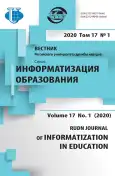Using AR-technology for mastering hieroglyphics as an approach to informatization of learning Chinese language in school
- Авторлар: Grinshkun V.V.1, Grigorieva A.S.2
-
Мекемелер:
- People Friendship University of Russia (RUDN University)
- “Perspektiva” school
- Шығарылым: Том 17, № 1 (2020)
- Беттер: 7-17
- Бөлім: DIDUCTIC ASPECTS OF EDUCATION INFORMATIZATION
- URL: https://journal-vniispk.ru/2312-8631/article/view/321233
- DOI: https://doi.org/10.22363/2312-8631-2020-17-1-7-17
- ID: 321233
Дәйексөз келтіру
Толық мәтін
Аннотация
Problem and goal. Methods are proposed for solving the problem of searching for information technologies, which, due to new approaches to information visualization, can increase the efficiency of students mastering hieroglyphics - one of the main and most difficult to study components of Chinese language learning systems. As a way to solve this problem, the application of augmented reality technology can be proposed, provided that the means and forms of its effective use are found in the framework of teaching the Chinese language in school. The aim of the study described in the article was the development and experimental confirmation of the effectiveness of approaches to teaching students in school hieroglyphic writing and the semantic interpretation of hieroglyphs based on the use of augmented reality tools. Methodology. A practical study was carried out on the basis of the formation of the experimental (63 people) and control (71 people) groups of students in grades 5 and 6. Schoolchildren of the experimental group were trained using augmented reality tools, hieroglyph markers, a specially selected collection of 3D models and developed tasks for comparing hieroglyphs and their semantic meanings, searching for hieroglyphics by their meanings, developing 3D models for visualizing the meanings of hieroglyphs. The analysis of the level of lexical skills of schoolchildren in terms of comparing hieroglyphs and their semantic values was carried out using integral indicators using methods of mathematical statistics. Results. It is shown that the proposed approach to using augmented reality technologies in the framework of teaching the Chinese language at school is effective. It is justified to create and develop collections of electronic versions of hieroglyphs and virtual objects that reflect the meaning of the main hieroglyphs studied at school. An effective method is when the students themselves are involved in such developments. Such approaches can play a significant role in informatization of educational systems for schoolchildren, as well as in establishing additional interdisciplinary ties. Conclusion. The effectiveness of the proposed approaches to the development of systems for preparing schoolchildren to study hieroglyphics in the framework of teaching the Chinese language based on the use of augmented reality technology has been experimentally confirmed. During the study, schoolchildren of the 5th and 6th grades showed an increased level of lexical skills in terms of comparing hieroglyphs and their semantic meanings, searching and writing hieroglyphs for a given semantic value.
Авторлар туралы
Vadim Grinshkun
People Friendship University of Russia (RUDN University)
Хат алмасуға жауапты Автор.
Email: vadim@grinshkun.ru
Russian Academy of Education corresponding member, doctor of pedagogical sciences, full professor, professor of the department of information technologies in continuous education
6 Miklukho-Maklaya St, Moscow, 117198, Russian FederationAnna Grigorieva
“Perspektiva” school
Email: ane4ka-grigoreva@mail.ru
teacher of foreign language of “Perspektiva” school
11а Sinyavinskaya St, Moscow, 141411, Russian FederationӘдебиет тізімі
- Grinshkun AV. Vozmozhnosti ispol'zovaniya tekhnologij dopolnennoj real'nosti pri obuchenii informatike shkol'nikov [Possibilities of using augmented reality technologies in teaching informatics to schoolchildren]. Vestnik Moskovskogo gorodskogo pedagogicheskogo universiteta. Serija: Informatika i informatizacija obrazovanija [Bulletin of the Moscow City Pedagogical University. Series: Informatics and Informatization of Education]. 2014;3(29):87–93.
- Grinshkun AV. Tekhnologiya dopolnennoj real'nosti i podhody k ee ispol'zovaniyu pri sozdanii uchebnyh zadanij dlya shkol'nikov [Technology of augmented reality and approaches to its use in creating educational tasks for schoolchildren]. Vestnik Moskovskogo gorodskogo pedagogicheskogo universiteta. Serija: Informatika i informatizacija obrazovanija [Bulletin of the Moscow City Pedagogical University. Series: Informatics and Informatization of Education]. 2017;3(41):99–105.
- Demina NA. Metodika prepodavaniya prakticheskogo kitajskogo yazyka [Method of teaching practical Chinese]. Moscow: Vostochnaya literature Publ.; 2006.
- Zadoenko TP, Huan SH. Nachal'nyj kurs kitajskogo yazyka [Initial course of the Chinese language] (vol. 1). Moscow: Vostochnaya kniga Publ.; 2010.
- Zadorozhnyh DP. Metodika prepodavaniya kitajskoj ieroglificheskoj pis'mennosti [Methods of teaching Chinese hieroglyphic writing]. Vestnik nauki Sibiri [Bulletin of science of Siberia]. 2014;1(11):182–187.
- Kondrashevskij AF, Rumyanceva MV, Frolova MG. Prakticheskij kurs kitajskogo yazyka [Practical course of the Chinese language] (vol. 1). Moscow: Vostochnaya kniga Publ.; 2010.
- Kochergin IV. Ocherki metodiki obucheniya kitajskomu yazyku [Essays on methods of teaching Chinese]. Moscow: Muravej Publ.; 2000.
- Filippov VM, Krasnova GA, Grinshkun VV. Transgranichnoe obrazovanie [cross-border education]. Platnoe obrazovanie [Paid education]. 2008;(6):36–38.
- Dong A, Suyang B, Behzadan T, Amir H, Chen K, Feng U, Kamat R, Vineet R. Collaborative visualization of engineering processes using tabletop augmented reality. Advances in Engineering Software. 2013;(55):45–55.
- Golonka EM, Bowles AR, Frank VM. Technologies for foreign language learning: a review of technology types and their effectiveness. Computer Assisted Language Learning. 2014;(27):70–105.
- Henderson S, Feiner S. Exploring the benefits of augmented reality documentation for maintenance and repair. IEEE transactions on visualization and computer graphics. 2011;17(10):1355–1368.
- Ke C. Effects of strategies on the learning of Chinese characters among foreign language studies. Journal of the Chinese Language Teachers Association. 1998;33(2):93–112.
- Livingston M.A. Evaluating human factors in augmented reality systems. IEEE Computer Graphics and Applications. 2005;25(6):6–9.
- McGinnis SН. Student attitudes and approaches in the learning of written Chinese. Paper presented at the Annual Conference of the American Association for Applied Linguistics. Long Beach; 1995. СА. 1.
- Onalbek ZK, Grinshkun VV, Omarov BS, Abuseytov BZ, Makhanbet ET, Kendzhaeva BB. The Main Systems and Types of Forming of Future Teacher-Trainers' Professional Competence. Life Science Journal. 2013;10(4):2397–2400.
Қосымша файлдар









